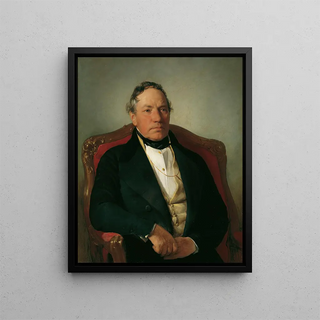Art print | Johann Nepomuk Reithoffer 1781-1872, the founder of the Austrian rubber industry - Friedrich von Amerling


View from behind

Frame (optional)
Reproduction of Johann Nepomuk Reithoffer 1781-1872, the founder of the Austrian rubber industry - Friedrich von Amerling – Captivating introduction
In the fascinating world of art, some works transcend the simple frame of the canvas to tell stories that resonate through time. The art print of Johann Nepomuk Reithoffer, created by Friedrich von Amerling, is one of these works. It captures not only the physical appearance of a man who marked the Austrian rubber industry but also evokes an era where innovation and craftsmanship intertwined to shape Austria's economic and cultural landscape. This portrait, imbued with profound humanity, invites the viewer to discover the personality of a man whose contributions have had a lasting impact on his country.
Style and uniqueness of the work
Von Amerling's work stands out for its striking realism and its ability to convey human emotions through facial features and body postures. In this portrait, Reithoffer is depicted with quiet dignity, his features carefully detailed, revealing a man who is both thoughtful and determined. Light plays a crucial role in this composition, highlighting the nuances of the face and clothing, while the neutral background emphasizes the central figure. This style, characteristic of the artist, combines impeccable technique with deep sensitivity, allowing the viewer to immerse themselves in the very essence of the subject. The color palette, subtle and harmonious, enhances the atmosphere of respect and admiration emanating from this work.
The artist and his influence
Friedrich von Amerling, an emblematic figure of the 19th century, is recognized for his mastery of portraiture and his skill in capturing the spirit of his time. Born in Vienna, he established himself as one of the most prominent artists of his era, influencing not only his contemporaries but also future generations. His approach to portraiture, which combines realism and idealization, paved the way for a new way of viewing the subject. Through his works, he immortalized influential personalities of his time, contributing to the construction of a collective memory. The choice of Reith

Matte finish

View from behind

Frame (optional)
Reproduction of Johann Nepomuk Reithoffer 1781-1872, the founder of the Austrian rubber industry - Friedrich von Amerling – Captivating introduction
In the fascinating world of art, some works transcend the simple frame of the canvas to tell stories that resonate through time. The art print of Johann Nepomuk Reithoffer, created by Friedrich von Amerling, is one of these works. It captures not only the physical appearance of a man who marked the Austrian rubber industry but also evokes an era where innovation and craftsmanship intertwined to shape Austria's economic and cultural landscape. This portrait, imbued with profound humanity, invites the viewer to discover the personality of a man whose contributions have had a lasting impact on his country.
Style and uniqueness of the work
Von Amerling's work stands out for its striking realism and its ability to convey human emotions through facial features and body postures. In this portrait, Reithoffer is depicted with quiet dignity, his features carefully detailed, revealing a man who is both thoughtful and determined. Light plays a crucial role in this composition, highlighting the nuances of the face and clothing, while the neutral background emphasizes the central figure. This style, characteristic of the artist, combines impeccable technique with deep sensitivity, allowing the viewer to immerse themselves in the very essence of the subject. The color palette, subtle and harmonious, enhances the atmosphere of respect and admiration emanating from this work.
The artist and his influence
Friedrich von Amerling, an emblematic figure of the 19th century, is recognized for his mastery of portraiture and his skill in capturing the spirit of his time. Born in Vienna, he established himself as one of the most prominent artists of his era, influencing not only his contemporaries but also future generations. His approach to portraiture, which combines realism and idealization, paved the way for a new way of viewing the subject. Through his works, he immortalized influential personalities of his time, contributing to the construction of a collective memory. The choice of Reith






